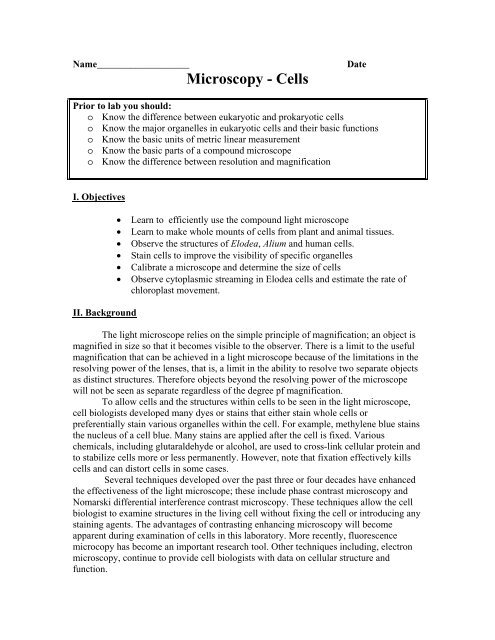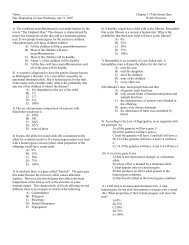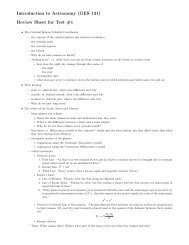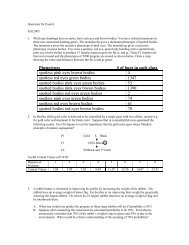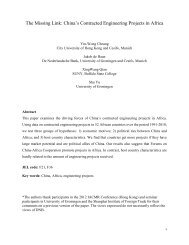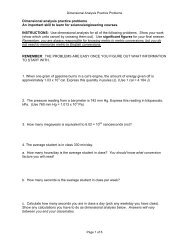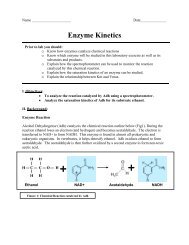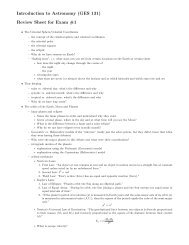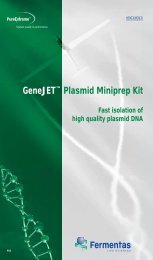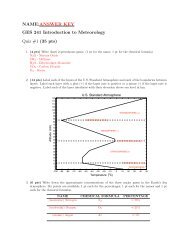Microscopy - Cells
Microscopy - Cells
Microscopy - Cells
Create successful ePaper yourself
Turn your PDF publications into a flip-book with our unique Google optimized e-Paper software.
Name___________________<strong>Microscopy</strong> - <strong>Cells</strong>DatePrior to lab you should:o Know the difference between eukaryotic and prokaryotic cellso Know the major organelles in eukaryotic cells and their basic functionso Know the basic units of metric linear measuremento Know the basic parts of a compound microscopeo Know the difference between resolution and magnificationI. ObjectivesII. Background• Learn to efficiently use the compound light microscope• Learn to make whole mounts of cells from plant and animal tissues.• Observe the structures of Elodea, Alium and human cells.• Stain cells to improve the visibility of specific organelles• Calibrate a microscope and determine the size of cells• Observe cytoplasmic streaming in Elodea cells and estimate the rate ofchloroplast movement.The light microscope relies on the simple principle of magnification; an object ismagnified in size so that it becomes visible to the observer. There is a limit to the usefulmagnification that can be achieved in a light microscope because of the limitations in theresolving power of the lenses, that is, a limit in the ability to resolve two separate objectsas distinct structures. Therefore objects beyond the resolving power of the microscopewill not be seen as separate regardless of the degree pf magnification.To allow cells and the structures within cells to be seen in the light microscope,cell biologists developed many dyes or stains that either stain whole cells orpreferentially stain various organelles within the cell. For example, methylene blue stainsthe nucleus of a cell blue. Many stains are applied after the cell is fixed. Variouschemicals, including glutaraldehyde or alcohol, are used to cross-link cellular protein andto stabilize cells more or less permanently. However, note that fixation effectively killscells and can distort cells in some cases.Several techniques developed over the past three or four decades have enhancedthe effectiveness of the light microscope; these include phase contrast microscopy andNomarski differential interference contrast microscopy. These techniques allow the cellbiologist to examine structures in the living cell without fixing the cell or introducing anystaining agents. The advantages of contrasting enhancing microscopy will becomeapparent during examination of cells in this laboratory. More recently, fluorescencemicrocopy has become an important research tool. Other techniques including, electronmicroscopy, continue to provide cell biologists with data on cellular structure andfunction.
III. MaterialsAvailable cells:Onion skin epidermal cells, cells of the aquatic plant Elodea, algal cells, humanepithelial cells taken from the lining of the cheek (squamous epithelial cells).Stains:Lugols’s Iodine, Methylene BlueEquipment and supplies:Compound Microscopes, Clear plastic mm rulers, Slides, Cover slips,Lens paper, sterile toothpicks.IV. ProceduresSee appendix on last page for detailed instructions on the use of the microscopeElodea1. Elodea is the genus name common group of water plants. They have very thinleaves and are used to show the typical structures of a plant cell.2. Place a portion of a living Elodea leaf on a slide in a small drop of water andplace a cover slip on top of it. The leaf has several layers and you will have tofocus on one layer using your fine adjustment.3. When you have focused on high power call your instructor.4. After receiving the OK, diagram your slide on the Lab report sheet.5. Indentify the following cell organelles: cell wall, cell membrane boundary,nucleus, sap vacuoles, chloroplasts, nucleus, and cytoplasm.6. The heat of the light will cause your slide to dry out quickly. This will cause yourcells to die. Work quickly and if necessary add a drop of water to prevent the cellfrom drying up.Allium (Onion) <strong>Cells</strong>1. The bulb of the onion provides a rich source of plant cells.2. With a razor blade, carefully peel a thin transparent piece of onion skin from oneof the slices provided. Follow your instructor’s example. Caution! Do not cutyourself.3. Focus on high power and call your instructor.4. Next add a drop of iodine stain on one side of the cover slip. Place a piece of lenspaper on the opposite side of the cover slip. The paper will "wick" the stain acrossthe specimen causing the nucleus to darken.5. When the onion cells have been stained, call your instructor again.
6. Diagram and label the following cell organelles; cell wall, cell membrane(boundary) cytoplasm, nucleus, nuclear membrane (boundary).Human Epithelial (Cheek) <strong>Cells</strong>The inside of your cheek is covered with epithelium skin cells. In this procedure you willprepare a slide and stain the nucleus of the cell by adding methylene blue.1. Carefully scrape the inside of your cheek with the blunt end of a toothpick.2. Smear the material on the center of a clean slide.3. Stain the cells by adding a drop of methylene blue.4. Cover with a cover slip.5. Focus on high power and call your instructor.6. Diagram and label the cell membrane (boundary), cytoplasm, nucleus and nuclearmembrane (boundary).Calibrating your microscopePlace a clear ruler on the stage and determine the diameter of the field of view whileusing the scanning objective (the shortest one). Adjust to medium power and again findthe diameter of the field of view at that power. Adjust to high power and find thediameter of its field of view. Now determine the total magnification of each objective bymultiplying the power of the objective (the even number printed on the objective) by theocular (the number that has a "x" behind it printed on the eye-piece).Fill in the table below:objective Eyepiece Magnification Field dia. (mm) Field dia. in µm*10x10x10x10x1 mm = 100 µm
Determining the rate of cytoplasmic streaming1. Make a new mount of Elodea. Estimate the length of a cell using the diameter of afield as a guide. Hint: Use the highest power objective that fits the length of the cell.Calculate the length of the cell as fraction of field dia.X dia, in µm.2. Find an Elodea cell that is exhibiting cyclosis (cytoplasmic streaming). During this process,chloroplasts (small green disk-shaped organelles) move in a circular fashion around the cell.Determine how long it takes for 1 chloroplast to move from one end of the cell to the other andrecord your data.3. Calculate the rate of movement of the chloroplast by using the length of the cell in µm and thetime required for the chloroplast to travel the length of the cell.Drawings: Draw cell to scale. Put the labels to the right. Indicate the magnification andfield diameterElodeaMagnification_____Field Dia._______
AliumMagnification_____Field Dia._______Cheek EpitheliumMagnification_____Field Dia._______
Appendix- Microscope technique:The Compound MicroscopeFigure 1 shows the parts of a modern bright field microscope:6. ocular (eyepiece):contains the second lens(enlarges image further)5. objective: contains thefirst lens (produces anenlarged/inverted image)Coarse adjustment knob:Focuses image by rapidlymoving the objective**not to be used on highpower4. iris diaphragm: controlsthe amount of light that hitsthe specimen3. substage condenser:focuses the light from theilluminator onto the slide2. illuminator window:light exits the base here1. illuminator: foundinside the base/provides lightFine adjustment knob:Focuses image by movingthe objective in smallincrements1. Start with low power• Place the slide(specimen side up) onthe stage so that thespecimen lines up withthe middle of theopening in the stage2. Turn the coarseadjustment knob slowly(while looking through thescope) to find the specimen• You may have tomove the slide aroundif this does not work3. After finding andfocusing on thespecimen, clarify theimage by using the fineadjustment knob4. Center the specimen inyour field of view whilelooking through themicroscope5. Once the specimen isfocused and centered, moveto the next power by turningto the next highest objectivelens.6. After switching power, ifyou see the specimen thenfocus the image using thefine adjustment• If you don’t see theimage, move backdown to low powerand start over


